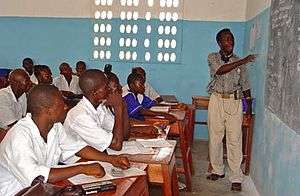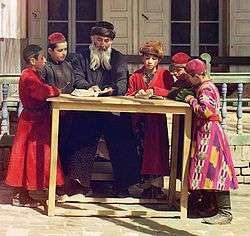Teacher
|
A teacher in a classroom at a secondary school in Pendembu, Sierra Leone. | |
| Occupation | |
|---|---|
| Names | Teacher, schoolteacher |
Occupation type | Profession |
Activity sectors | Education |
| Description | |
| Competencies | Teaching abilities, pleasant disposition, patience |
Education required | Teaching certification |
Related jobs | Professor, academic, lecturer, tutor |
A teacher (also called a school teacher) or educator is a person who provides education for students.
Duties and functions
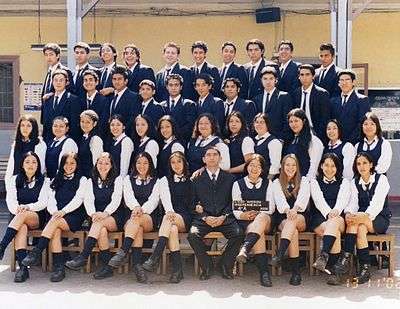
The role of teacher is often formal and ongoing, carried out at a school or other place of formal education. In many countries, a person who wishes to become a teacher must first obtain specified professional qualifications or credentials from a university or college. These professional qualifications may include the study of pedagogy, the science of teaching. Teachers, like other professionals, may have to continue their education after they qualify, a process known as continuing professional development. Teachers may use a lesson plan to facilitate student learning, providing a course of study which is called the curriculum.
A teacher's role may vary among cultures. Teachers may provide instruction in literacy and numeracy, craftsmanship or vocational training, the arts, religion, civics, community roles, or life skills.
A teacher who facilitates education for an individual may also be described as a personal tutor, or, largely historically, a governess.
In some countries, formal education can take place through home schooling. Informal learning may be assisted by a teacher occupying a transient or ongoing role, such as a family member, or by anyone with knowledge or skills in the wider community setting.
Religious and spiritual teachers, such as gurus, mullahs, rabbis, pastors/youth pastors and lamas, may teach religious texts such as the Quran, Torah or Bible.
Professional educators

Teaching may be carried out informally, within the family, which is called homeschooling, or in the wider community. Formal teaching may be carried out by paid professionals. Such professionals enjoy a status in some societies on a par with physicians, lawyers, engineers, and accountants (Chartered or CPA).
A teacher's professional duties may extend beyond formal teaching. Outside of the classroom teachers may accompany students on field trips, supervise study halls, help with the organization of school functions, and serve as supervisors for extracurricular activities. In some education systems, teachers may have responsibility for student discipline.
Around the world teachers are often required to obtain specialized education, knowledge, codes of ethics and internal monitoring.
There are a variety of bodies designed to instill, preserve and update the knowledge and professional standing of teachers. Around the world many governments operate teacher's colleges, which are generally established to serve and protect the public interest through certifying, governing and enforcing the standards of practice for the teaching profession.
The functions of the teacher's colleges may include setting out clear standards of practice, providing for the ongoing education of teachers, investigating complaints involving members, conducting hearings into allegations of professional misconduct and taking appropriate disciplinary action and accrediting teacher education programs. In many situations teachers in publicly funded schools must be members in good standing with the college, and private schools may also require their teachers to be college peoples. In other areas these roles may belong to the State Board of Education, the Superintendent of Public Instruction, the State Education Agency or other governmental bodies. In still other areas Teaching Unions may be responsible for some or all of these duties.
Pedagogy and teaching

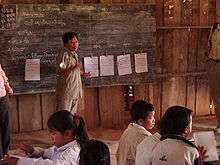
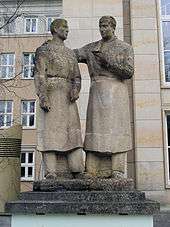
In education, teachers facilitate student learning, often in a school or academy or perhaps in another environment such as outdoors. A teacher who teaches on an individual basis may be described as a tutor.
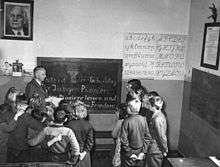
The objective is typically accomplished through either an informal or formal approach to learning, including a course of study and lesson plan that teaches skills, knowledge and/or thinking skills. Different ways to teach are often referred to as pedagogy. When deciding what teaching method to use teachers consider students' background knowledge, environment, and their learning goals as well as standardized curricula as determined by the relevant authority. Many times, teachers assist in learning outside of the classroom by accompanying students on field trips. The increasing use of technology, specifically the rise of the internet over the past decade, has begun to shape the way teachers approach their roles in the classroom.
The objective is typically a course of study, lesson plan, or a practical skill. A teacher may follow standardized curricula as determined by the relevant authority. The teacher may interact with students of different ages, from infants to adults, students with different abilities and students with learning disabilities.
Teaching using pedagogy also involve assessing the educational levels of the students on particular skills. Understanding the pedagogy of the students in a classroom involves using differentiated instruction as well as supervision to meet the needs of all students in the classroom. Pedagogy can be thought of in two manners. First, teaching itself can be taught in many different ways, hence, using a pedagogy of teaching styles. Second, the pedagogy of the learners comes into play when a teacher assesses the pedagogic diversity of his/her students and differentiates for the individual students accordingly. For example, an experienced teacher and parent described the place of a teacher in learning as follows: "The real bulk of learning takes place in self-study and problem solving with a lot of feedback around that loop. The function of the teacher is to pressure the lazy, inspire the bored, deflate the cocky, encourage the timid, detect and correct individual flaws, and broaden the viewpoint of all. This function looks like that of a coach using the whole gamut of psychology to get each new class of rookies off the bench and into the game."[1]
Perhaps the most significant difference between primary school and secondary school teaching is the relationship between teachers and children. In primary schools each class has a teacher who stays with them for most of the week and will teach them the whole curriculum. In secondary schools they will be taught by different subject specialists each session during the week and may have ten or more different teachers. The relationship between children and their teachers tends to be closer in the primary school where they act as form tutor, specialist teacher and surrogate parent during the course of the day.
This is true throughout most of the United States as well. However, alternative approaches for primary education do exist. One of these, sometimes referred to as a "platoon" system, involves placing a group of students together in one class that moves from one specialist to another for every subject. The advantage here is that students learn from teachers who specialize in one subject and who tend to be more knowledgeable in that one area than a teacher who teaches many subjects. Students still derive a strong sense of security by staying with the same group of peers for all classes.
Co-teaching has also become a new trend amongst educational institutions. Co-teaching is defined as two or more teachers working harmoniously to fulfill the needs of every student in the classroom. Co-teaching focuses the student on learning by providing a social networking support that allows them to reach their full cognitive potential. Co-teachers work in sync with one another to create a climate of learning.
Rights to enforce school discipline
Throughout the history of education the most common form of school discipline was corporal punishment. While a child was in school, a teacher was expected to act as a substitute parent, with all the normal forms of parental discipline open to them.

In past times, corporal punishment (spanking or paddling or caning or strapping or birching the student in order to cause physical pain) was one of the most common forms of school discipline throughout much of the world. Most Western countries, and some others, have now banned it, but it remains lawful in the United States following a US Supreme Court decision in 1977 which held that paddling did not violate the US Constitution.[2]
30 US states have banned corporal punishment, the others (mostly in the South) have not. It is still used to a significant (though declining) degree in some public schools in Alabama, Arkansas, Georgia, Louisiana, Mississippi, Oklahoma, Tennessee and Texas. Private schools in these and most other states may also use it. Corporal punishment in American schools is administered to the seat of the student's trousers or skirt with a specially made wooden paddle. This often used to take place in the classroom or hallway, but nowadays the punishment is usually given privately in the principal's office.
Official corporal punishment, often by caning, remains commonplace in schools in some Asian, African and Caribbean countries. For details of individual countries see School corporal punishment.
Currently detention is one of the most common punishments in schools in the United States, the UK, Ireland, Singapore and other countries. It requires the pupil to remain in school at a given time in the school day (such as lunch, recess or after school); or even to attend school on a non-school day, e.g. "Saturday detention" held at some schools. During detention, students normally have to sit in a classroom and do work, write lines or a punishment essay, or sit quietly.
A modern example of school discipline in North America and Western Europe relies upon the idea of an assertive teacher who is prepared to impose their will upon a class. Positive reinforcement is balanced with immediate and fair punishment for misbehavior and firm, clear boundaries define what is appropriate and inappropriate behavior. Teachers are expected to respect their students; sarcasm and attempts to humiliate pupils are seen as falling outside of what constitutes reasonable discipline.
Whilst this is the consensus viewpoint amongst the majority of academics, some teachers and parents advocate a more assertive and confrontational style of discipline. Such individuals claim that many problems with modern schooling stem from the weakness in school discipline and if teachers exercised firm control over the classroom they would be able to teach more efficiently. This viewpoint is supported by the educational attainment of countries—in East Asia for instance—that combine strict discipline with high standards of education.
It's not clear, however that this stereotypical view reflects the reality of East Asian classrooms or that the educational goals in these countries are commensurable with those in Western countries. In Japan, for example, although average attainment on standardized tests may exceed those in Western countries, classroom discipline and behavior is highly problematic. Although, officially, schools have extremely rigid codes of behavior, in practice many teachers find the students unmanageable and do not enforce discipline at all.
Where school class sizes are typically 40 to 50 students, maintaining order in the classroom can divert the teacher from instruction, leaving little opportunity for concentration and focus on what is being taught. In response, teachers may concentrate their attention on motivated students, ignoring attention-seeking and disruptive students. The result of this is that motivated students, facing demanding university entrance examinations, receive disproportionate resources. Given the emphasis on attainment of university places, administrators and governors may regard this policy as appropriate.
Obligation to honor students rights
Sudbury model democratic schools claim that popularly based authority can maintain order more effectively than dictatorial authority for governments and schools alike. They also claim that in these schools the preservation of public order is easier and more efficient than anywhere else. Primarily because rules and regulations are made by the community as a whole, thence the school atmosphere is one of persuasion and negotiation, rather than confrontation since there is no one to confront. Sudbury model democratic schools' proponents argue that a school that has good, clear laws, fairly and democratically passed by the entire school community, and a good judicial system for enforcing these laws, is a school in which community discipline prevails, and in which an increasingly sophisticated concept of law and order develops, against other schools today, where rules are arbitrary, authority is absolute, punishment is capricious, and due process of law is unknown.[3][4]
Teacher enthusiasm

Since teachers can affect how students perceive the course materials, it has been found that teachers who showed enthusiasm towards the course materials and students can affect a positive learning experience towards the course materials. On teacher/course evaluations, it was found that teachers who have a positive disposition towards the course content tend to transfer their passion to receptive students.[5] These teachers do not teach by rote but attempt to find new invigoration for the course materials on a daily basis.[6] One of the difficulties in this approach is that teachers may have repeatedly covered a curriculum until they begin to feel bored with the subject which in turn bores the students as well. Students who had enthusiastic teachers tend to rate them higher than teachers who didn't show much enthusiasm for the course materials.[7]

Teachers that exhibit enthusiasm can lead to students who are more likely to be engaged, interested, energetic, and curious about learning the subject matter. Recent research has found a correlation between teacher enthusiasm and students' intrinsic motivation to learn and vitality in the classroom.[8] Controlled, experimental studies exploring intrinsic motivation of college students has shown that nonverbal expressions of enthusiasm, such as demonstrative gesturing, dramatic movements which are varied, and emotional facial expressions, result in college students reporting higher levels of intrinsic motivation to learn.[9] Students who experienced a very enthusiastic teacher were more likely to read lecture material outside of the classroom.
There are various mechanisms by which teacher enthusiasm may facilitate higher levels of intrinsic motivation.[10] Teacher enthusiasm may contribute to a classroom atmosphere full of energy and enthusiasm which feed student interest and excitement in learning the subject matter.[11] Enthusiastic teachers may also lead to students becoming more self-determined in their own learning process. The concept of mere exposure indicates that the teacher's enthusiasm may contribute to the student's expectations about intrinsic motivation in the context of learning. Also, enthusiasm may act as a "motivational embellishment"; increasing a student's interest by the variety, novelty, and surprise of the enthusiastic teacher's presentation of the material. Finally, the concept of emotional contagion, may also apply. Students may become more intrinsically motivated by catching onto the enthusiasm and energy of the teacher.
Research shows that student motivation and attitudes towards school are closely linked to student-teacher relationships. Enthusiastic teachers are particularly good at creating beneficial relations with their students. Their ability to create effective learning environments that foster student achievement depends on the kind of relationship they build with their students.[12][13][14][15] Useful teacher-to-student interactions are crucial in linking academic success with personal achievement.[16] Here, personal success is a student's internal goal of improving himself, whereas academic success includes the goals he receives from his superior. A teacher must guide his student in aligning his personal goals with his academic goals. Students who receive this positive influence show stronger self-confidence and greater personal and academic success than those without these teacher interactions.[15][17][18]
Students are likely to build stronger relations with teachers who are friendly and supportive and will show more interest in courses taught by these teachers.[16][17] Teachers that spend more time interacting and working directly with students are perceived as supportive and effective teachers. Effective teachers have been shown to invite student participation and decision making, allow humor into their classroom, and demonstrate a willingness to play.[13]
The way a teacher promotes the course they are teaching, the more the student will get out of the subject matter. The three most important aspects of teacher enthusiasm are enthusiasm about teaching, enthusiasm about the students, and enthusiasm about the subject matter. A teacher must enjoy teaching. If they do not enjoy what they are doing, the students will be able to tell. They also must enjoy being around their students. A teacher who cares for their students is going to help that individual succeed in their life in the future. The teacher also needs to be enthusiastic about the subject matter they are teaching. For example, a teacher talking about chemistry needs to enjoy the art of chemistry and show that to their students. A spark in the teacher may create a spark of excitement in the student as well. An enthusiastic teacher has the ability to be very influential in the young student's life.
Misconduct and gender balance
Misconduct by teachers, especially sexual misconduct, has been getting increased scrutiny from the media and the courts.[19] A study by the American Association of University Women reported that 9.6% of students in the United States claim to have received unwanted sexual attention from an adult associated with education; be they a volunteer, bus driver, teacher, administrator or other adult; sometime during their educational career.[20]
A study in England showed a 0.3% prevalence of sexual abuse by any professional, a group that included priests, religious leaders, and case workers as well as teachers.[21] It is important to note, however, that the British study referenced above is the only one of its kind and consisted of "a random ... probability sample of 2,869 young people between the ages of 18 and 24 in a computer-assisted study" and that the questions referred to "sexual abuse with a professional," not necessarily a teacher. It is therefore logical to conclude that information on the percentage of abuses by teachers in the United Kingdom is not explicitly available and therefore not necessarily reliable. The AAUW study, however, posed questions about fourteen types of sexual harassment and various degrees of frequency and included only abuses by teachers. "The sample was drawn from a list of 80,000 schools to create a stratified two-stage sample design of 2,065 8th to 11th grade students"Its reliability was gauged at 95% with a 4% margin of error.
In the United States especially, several high-profile cases such as Debra LaFave, Pamela Rogers, and Mary Kay Letourneau have caused increased scrutiny on teacher misconduct.
Chris Keates, the general secretary of National Association of Schoolmasters Union of Women Teachers, said that teachers who have sex with pupils over the age of consent should not be placed on the sex offenders register and that prosecution for statutory rape "is a real anomaly in the law that we are concerned about." This has led to outrage from child protection and parental rights groups.[22] Fears of being labelled a pedophile or hebephile has led to several men who enjoy teaching avoiding the profession.[23] This has in some jurisdictions reportedly led to a shortage of male teachers.[24]
Occupational hazards
Teachers face several occupational hazards in their line of work, including occupational stress, which can negatively impact teachers' mental and physical health, productivity, and students' performance. Stress can be caused by organizational change, relationships with students, fellow teachers, and administrative personnel, working environment, expectations to substitute, long hours with a heavy workload, and inspections. Teachers are also at high risk for occupational burnout.[25]
A 2000 study found that 42% of UK teachers experienced occupational stress, twice the figure for the average profession. A 2012 study found that teachers experienced double the rate of anxiety, depression, and stress than average workers.[25]
There are several ways to mitigate the occupational hazards of teaching. Organizational interventions, like changing teachers' schedules, providing support networks and mentoring, changing the work environment, and offering promotions and bonuses, may be effective in helping to reduce occupational stress among teachers. Individual-level interventions, including stress-management training and counseling, are also used to relieve occupational stress among teachers.[25]
Teaching around the world


There are many similarities and differences among teachers around the world. In almost all countries teachers are educated in a university or college. Governments may require certification by a recognized body before they can teach in a school. In many countries, elementary school education certificate is earned after completion of high school. The high school student follows an education specialty track, obtain the prerequisite "student-teaching" time, and receive a special diploma to begin teaching after graduation. In addition to certification, many educational institutions especially within the US, require that prospective teachers pass a background check and psychiatric evaluation to be able to teach in classroom. This is not always the case with adult further learning institutions but is fast becoming the norm in many countries as security[16] concerns grow.
International schools generally follow an English-speaking, Western curriculum and are aimed at expatriate communities.[26]
Australia
Education in Australia is primarily the responsibility of the individual states and territories. Generally, education in Australia follows the three-tier model which includes primary education (primary schools), followed by secondary education (secondary schools/high schools) and tertiary education (universities and/or TAFE colleges).
Canada
Teaching in Canada requires a post-secondary degree Bachelor's Degree. In most provinces a second Bachelor's Degree such as a Bachelor of Education is required to become a qualified teacher. Salary ranges from $40,000/year to $90,000/yr. Teachers have the option to teach for a public school which is funded by the provincial government or teaching in a private school which is funded by the private sector, businesses and sponsors.
France
In France, teachers, or professors, are mainly civil servants, recruited by competitive examination.
Germany
In Germany, teachers are mainly civil servants recruited in special university classes, called Lehramtstudien (Teaching Education Studies). There are many differences between the teachers for elementary schools (Grundschule), lower secondary schools (Hauptschule), middle level secondary schools (Realschule) and higher level secondary schools (Gymnasium). Salaries for teachers depend on the civil servants' salary index scale (Bundesbesoldungsordnung).
Ireland
Salaries for primary teachers in Ireland depend mainly on seniority (i.e. holding the position of principal, deputy principal or assistant principal), experience and qualifications. Extra pay is also given for teaching through the Irish language, in a Gaeltacht area or on an island. The basic pay for a starting teacher is €27,814 p.a., rising incrementally to €53,423 for a teacher with 25 years service. A principal of a large school with many years experience and several qualifications (M.A., H.Dip., etc.) could earn over €90,000.[27]
Teachers are required to be registered with the Teaching Council; under Section 30 of the Teaching Council Act 2001, a person employed in any capacity in a recognised teaching post - who is not registered with the Teaching Council - may not be paid from Oireachtas funds.[28][29]
From 2006 Garda vetting has been introduced for new entrants to the teaching profession. These procedures apply to teaching and also to non-teaching posts and those who refuse vetting "cannot be appointed or engaged by the school in any capacity including in a voluntary role". Existing staff will be vetted on a phased basis.[30][31]
United Kingdom

Education in the United Kingdom is a devolved matter with each of the countries of the United Kingdom having separate systems.
England
Salaries for Nursery, Primary and Secondary School teachers ranged from £20,133 to £41,004 in September 2007, although some salaries can go much higher depending on experience and extra responsibilities.[32] Preschool teachers may earn £20,980 annually. Teachers in state schools must have at least a bachelor's degree, complete an approved teacher education program, and be licensed.
Many counties offer alternative licensing programs to attract people into teaching, especially for hard-to-fill positions. Excellent job opportunities are expected as retirements, especially among secondary school teachers, outweigh slowing enrollment growth; opportunities will vary by geographic area and subject taught.
Scotland
In Scotland, anyone wishing to teach must be registered with the General Teaching Council for Scotland (GTCS). Teaching in Scotland is an all graduate profession and the normal route for graduates wishing to teach is to complete a programme of Initial Teacher Education (ITE) at one of the seven Scottish Universities who offer these courses. Once successfully completed, "Provisional Registration" is given by the GTCS which is raised to "Full Registration" status after a year if there is sufficient evidence to show that the "Standard for Full Registration" has been met.[33]
For the salary year beginning April 2008, unpromoted teachers in Scotland earned from £20,427 for a Probationer, up to £32,583 after 6 years teaching, but could then go on to earn up to £39,942 as they complete the modules to earn Chartered Teacher Status (requiring at least 6 years at up to two modules per year.) Promotion to Principal Teacher positions attracts a salary of between £34,566 and £44,616; Deputy Head, and Head teachers earn from £40,290 to £78,642.[34] Teachers in Scotland can be registered members of trade unions with the main ones being the Educational Institute of Scotland and the Scottish Secondary Teachers' Association.
Wales
Education in Wales differs in certain respects from education elsewhere in the United Kingdom. For example, a significant number of students all over Wales are educated either wholly or largely through the medium of Welsh: in 2008/09, 22 per cent of classes in maintained primary schools used Welsh as the sole or main medium of instruction. Welsh medium education is available to all age groups through nurseries, schools, colleges and universities and in adult education; lessons in the language itself are compulsory for all pupils until the age of 16.
Teachers in Wales can be registered members of trade unions such as ATL, NUT or NASUWT and reports in recent years suggest that the average age of teachers in Wales is falling with teachers being younger than in previous years.[35] A growing cause of concern are that attacks on teachers in Welsh schools which reached an all-time high between 2005 and 2010.[36]
United States
In the United States, each state determines the requirements for getting a license to teach in public schools. Teaching certification generally lasts three years, but teachers can receive certificates that last as long as ten years.[37] Public school teachers are required to have a bachelor's degree and the majority must be certified by the state in which they teach. Many charter schools do not require that their teachers be certified, provided they meet the standards to be highly qualified as set by No Child Left Behind. Additionally, the requirements for substitute/temporary teachers are generally not as rigorous as those for full-time professionals. The Bureau of Labor Statistics estimates that there are 1.4 million elementary school teachers,[38] 674,000 middle school teachers,[39] and 1 million secondary school teachers employed in the U.S.[40]
In the past, teachers have been paid relatively low salaries. However, average teacher salaries have improved rapidly in recent years. US teachers are generally paid on graduated scales, with income depending on experience. Teachers with more experience and higher education earn more than those with a standard bachelor's degree and certificate. Salaries vary greatly depending on state, relative cost of living, and grade taught. Salaries also vary within states where wealthy suburban school districts generally have higher salary schedules than other districts. The median salary for all primary and secondary teachers was $46,000 in 2004, with the average entry salary for a teacher with a bachelor's degree being an estimated $32,000. Median salaries for preschool teachers, however, were less than half the national median for secondary teachers, clock in at an estimated $21,000 in 2004.[41] For high school teachers, median salaries in 2007 ranged from $35,000 in South Dakota to $71,000 in New York, with a national median of $52,000.[42] Some contracts may include long-term disability insurance, life insurance, emergency/personal leave and investment options.[43] The American Federation of Teachers' teacher salary survey for the 2006-07 school year found that the average teacher salary was $51,009.[44] In a salary survey report for K-12 teachers, elementary school teachers had the lowest median salary earning $39,259. High school teachers had the highest median salary earning $41,855.[45] Many teachers take advantage of the opportunity to increase their income by supervising after-school programs and other extracurricular activities. In addition to monetary compensation, public school teachers may also enjoy greater benefits (like health insurance) compared to other occupations. Merit pay systems are on the rise for teachers, paying teachers extra money based on excellent classroom evaluations, high test scores and for high success at their overall school. Also, with the advent of the internet, many teachers are now selling their lesson plans to other teachers through the web in order to earn supplemental income, most notably on TeachersPayTeachers.com.[46]
Spiritual teacher
There are many forms of spiritual or religious teachers in Christianity, across all three major traditions - (Roman) Catholic, (Eastern) Orthodox Catholic, and Protestant/Non-Denominational, with a stronger tradition of spiritual formation in the more historic and authoritarian/hierarchical Christian traditions with a long tradition of "discernment of spirits", of vocations, and other aspects of spiritual life, especially the Roman and Orthodox Catholic Churches. These positions include: the honoured but informal position of starets or elder - a man (or, less often, woman), often a monastic, considered to be graced by God with certain gifts for the guidance of souls and the detection and correction of prelest (spiritual pride or deception) - who acts as a spiritual guide or father in the Orthodox Catholic tradition, especially Russian Orthodoxy (see Optina Monastery, which had a long line of said starets); the Priest or Confessor in Roman Catholicism, who is often a man in Holy Orders but may be a monastic or other person respected for his spiritual accomplishments or acumen (even the Pope of Rome has a Confessor, who is not always a bishop, and, due to the hierarchical structure of the Roman Church, can not be his equal in authority), which is often a semi-official to official position, as opposed to the unofficial positions of spiritual guides in the Orthodox Catholic and Protestant traditions; and the almost-exclusively informal arrangements (generally formal only in members who are under some form of church discipline) of mentorship (both of adults and children, in the latter case often a youth pastor) in the Protestant and Non-Denominational traditions, which boundaries can be blurred with the more typically Roman "confessor" position in some of the more historic and conservative Reformation Churches, such as some of the Lutheran and Anglican. In keeping with the individualistic nature of most Protestant denominations, the emphasis on being guided in spiritual development is small, with a heavy emphasis placed on heavy reading and personal, Spirit-enlightened interpretation of the Holy Bible.
In The Church of Jesus Christ of Latter-day Saints (LDS Church), the teacher is an office in the Aaronic priesthood, generally conferred on young boys or recent converts, and has little in common with the "spiritual teacher" archetype. The role of "spiritual teacher" may be filled by many individuals in the LDS Church, often a trusted friend, who may hold any office, from Elder to Bishop, or no office at all. The emphasis on spiritual mentorship in the LDS Church is similar to that in the more "low-church" traditions of Protestantism, with a stronger emphasis placed on the husband and father of a family to provide spiritual guidance for all of his family, ideally in consultation with his wife, even if the husband is not a member of the LDS Church, based on interpretatios of certain Biblical texts which proclaim the spiritual authority of husbands in marriage. Even Priesthood representatives are expected to defer to the father of the house when in his home. Further, additional spiritual guidance is offered by those holding the office of Patriarch, which is supposed by Latter-day Saints to grant certain gifts of the Spirit, such as the ability to prophesy, to its holders. This guidance is generally offered during a ceremony called the patriarchal blessing.
In Hinduism the spiritual teacher is known as a guru, and, in many traditions of Hinduism - especially those common in the West - the emphasis on spiritual mentorship is extremely high, with gurus often exercising a great deal of control over the lives of their disciples.
In Tibetan Buddhism the teachers of Dharma in Tibet are most commonly called a Lama. A Lama who has through phowa and siddhi consciously determined to be reborn, often many times, in order to continue their Bodhisattva vow is called a Tulku.
There are many concepts of teachers in Islam, ranging from mullahs (the teachers at madrassas) to ulemas, who teach of the laws of Islam for the proper way of Islamic living according to the Sunnah and Ahadith, and can render legal verdicts upon matters of Islamic law in accordance with the teaching of one of the Four Schools of Jurisprudence. In the more spiritual or mystical Islamic tradition of Sufism, the position of spiritual teacher and an esoteric (as opposed to exoteric, or actions-oriented, e.g. the Five Pillars of Islam) spirituality and spiritual knowledge takes on a more important dimension, with emphasis on learning from living saints - the highest of which is a Qutb - and of traditions passed down from initiate to initiate, and traceable back to the founder of the order.
A Rabbi is generally regarded as the Jewish spiritual teacher, and has many other responsibilities.
Popular educators
See also
References
- ↑ Walter Evans (1965) letter to Roy Glasgow of Naval Postgraduate School, quoted by his son Gregory Walter Evans (December 2004) "Bringing Root Locus to the Classroom", IEEE Control Systems Magazine, page 81
- ↑ "Ingraham v. Wright". Bucknell.edu. Retrieved 2011-07-31.
- ↑ The Crisis in American Education — An Analysis and a Proposal, The Sudbury Valley School (1970), Law and Order: Foundations of Discipline (pg. 49-55). Retrieved November 15, 2009.
- ↑ Greenberg, D. (1987) The Sudbury Valley School Experience "Back to Basics - Political basics."
Knowing all this, we would expect; nay, insist (one would think) that the schools, in training their students to contribute productively to the political stability and growth of America, would be democratic and non-autocratic; be governed by clear rules and due process; be guardians of individual rights of students. A student growing up in schools having these features would be ready to move right into society at large. I think it is safe to say that the individual liberties so cherished by our ancestors and by each succeeding generation will never be really secure until our youth, throughout the crucial formative years of their minds and spirits, are nurtured in a school environment that embodies these basic American truths.
Retrieved January 4, 2010. - ↑ Teaching Patterns: a Pattern Language for Improving the Quality of Instruction in Higher Education Settings by Daren Olson. Page 96
- ↑ Motivated Student: Unlocking the Enthusiasm for Learning by Bob Sullo. Page 62
- ↑ Barkley, S., & Bianco, T. (2006). The Wonder of Wows. Kappa Delta Pi Record, 42(4), 148-151.
- ↑ Patrick, B.C., Hisley, J. & Kempler, T. (2000) "What's Everybody so Excited about?": The Effects of Teacher Enthusiasm on Student Intrinsic Motivation and Vitality", The Journal of Experimental Education, Vol. 68, No. 3, pp. 217-236
- ↑ Brooks, Douglas M. (1985). "The Teacher's Communicative Competence: The First Day of School". Theory Into Practice. 24 (1): 63.
- ↑ All Of Us Should Be Teachers, Even If Just For One Day, Huffington Post, 27 September 2016
- ↑ Amatora, M. (1950). Teacher Personality: Its Influence on Pupils. Education, 71(3), 154-158
- ↑ Baker, J. A., Terry, T., Bridger, R., & Winsor, A. (1997). Schools as caring communities: A relational approach to school reform. School Psychology Review, 26, 576-588.
- 1 2 Bryant, Jennings . 1980. Relationship between college teachers' use of humor in the classroom and students' evaluations of their teachers. Journal of educational psychology. 72, 4.
- ↑ Fraser, B. J., & Fisher, D. L. (1982). Predicting students' outcomes from their perceptions of classroom psychosocial environment. American Educational Research Journal, 19, 498- 518.
- 1 2 Hartmut, J. (1978). Supportive dimensions of teacher behavior in relationship to pupil emotional cognitive processes. Psychologie in Erziehung und Unterricht, 25, 69-74.
- 1 2 3 Osborne, E.;. Salzberger, I.; Wittenberg, G. W.. 1999. The Emotional Experience of Learning and Teaching. Karnac Books, London.
- 1 2 Baker, J. A.Teacher-Student Interaction in Urban At-Risk Classrooms: Differential Behavior, Relationship Quality, and Student Satisfaction with School. The Elementary School Journal Volume 100, Number 1, 1999 by The University of Chicago.
- ↑ Moos, R. H. (1979). Evaluating Educational Environments: Measures, procedures, findings, and policy implications. San Francisco: Jossey-Bass.
- ↑ Goorian, Brad (December 1999). "Sexual Misconduct by School Employees" (PDF). ERIC Digest (134): 1. ERIC #: ED436816. Archived from the original (PDF) on 2008-02-27. Retrieved 2008-01-17.
- ↑ Shakeshaft, Charol (June 2004). "Educator Sexual Misconduct: A Synthesis of Existing Literature" (PDF). U.S. Department of Education, Office of the Under Secretary. p. 28. Retrieved 2008-01-17.
- ↑ Educator Sexual Misconduct: A Synthesis of Existing Literature see page 8 and page 20
- ↑ "Union Official: Teachers Who Engage in Consensual Sex With Teen Pupils Shouldn't Face Prosecution". Fox News. 2008-10-06.
- ↑ Kissen, Rita (2002). Getting Ready for Benjamin: Preparing Teachers for Sexual Diversity in the classroom. p. 62.
- ↑ http://www.abc.net.au/7.30/stories/s72521.htm
- 1 2 3 Naghieh, Ali; Montgomery, Paul; Bonell, Christopher P.; Thompson, Marc; Aber, J. Lawrence (2015). "Organisational interventions for improving wellbeing and reducing work-related stress in teachers". The Cochrane Database of Systematic Reviews. 4: CD010306. doi:10.1002/14651858.CD010306.pub2. ISSN 1469-493X. PMID 25851427.
- ↑ Teachers International Consultancy (2008-07-17). "Teaching at international schools is not TEFL". Retrieved 2009-01-10.
- ↑ "Circular 0040/2011 (New Pay Scales for New Appointees to Teaching in 2011)" (PDF). Department of Education, Ireland. Retrieved 23 July 2012.
- ↑ "Requirement For Teachers To Be Registered With The Teaching Council Under Section 30 Of The Teaching Council Act, 2001". Department of Education and Skills, Ireland. Retrieved 23 July 2012.
- ↑ "Teaching Council Act, 2001". Office of the Attorney General, Ireland. Retrieved 23 July 2012.
- ↑ "New arrangements for the vetting of teaching and non-teaching staff". Department of Education and Science, Ireland. Retrieved 23 July 2012.
- ↑ "Recruitment procedures – requirements for Garda vetting". Department of Education and Science, Ireland. Retrieved 23 July 2012.
- ↑ "'Teacher Salaries from September 2007' TDA (Training and Development Agency)" (PDF). Tda.gov.uk. 2011-03-31. Retrieved 2011-07-31.
- ↑ Training to be a teacher GTC Scotland
- ↑
- ↑ "Wales' teachers 'getting younger'". BBC News. 2010-04-20.
- ↑ "Attacks on teachers in Wales on the rise". BBC News. 2010-10-07.
- ↑ "Teacher certification". Teacherportal.com. Retrieved 2011-07-31.
- ↑ "Elementary School Teachers, Except Special Education". Bls.gov. 2011-05-17. Retrieved 2011-07-31.
- ↑ "Middle School Teachers, Except Special and Vocational Education". Bls.gov. 2011-05-17. Retrieved 2011-07-31.
- ↑ "Secondary School Teachers, Except Special and Vocational Education". Bls.gov. 2011-05-17. Retrieved 2011-07-31.
- ↑ "U.S. Department of Labor: Bureau of Labor Statistics. (July 18, 2007). Teachers—Preschool, Kindergarten, Elementary, Middle, and Secondary: Earnings". Retrieved 2007-10-11.
- ↑ "U.S. Department of Labor: Bureau of Labor Statistics. (August, 2007). Spotlight on Statistics: Back to School". Retrieved 2007-10-11.
- ↑ "Make It Happen: A Student's Guide," National Education Association. Retrieved 7/5/07.
- ↑ 2007 "Survey & Analysis of Teacher Salary Trends," American Federation of Teachers. Retrieved 8/7/10.
- ↑ 2008 "Teacher Salary- Average Teacher Salaries" PayScale. Retrieved 9/16/08.
- ↑ Hu, Winnie (2009-11-14). "Selling Lessons Online Raises Cash and Questions". Nytimes.com. Retrieved 2011-07-31.
External links
| Wikiquote has quotations related to: Teachers |
| Look up teacher in Wiktionary, the free dictionary. |
![]() Media related to Teaching at Wikimedia Commons
Media related to Teaching at Wikimedia Commons
